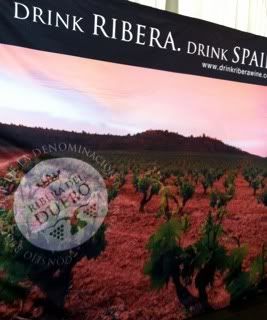Spanish wine publicists have been beating the streets for the past few years, trying to carve out a bigger piece of the American wine pie. Spain is trying to claw their way to higher visibility among U.S. wine drinkers. They are presently fourth on the list of America’s favorite European wine, and struggling to nudge producers like Australia, Argentina, Chile and South Africa out of the way. Individual wine regions
within Spain sometimes seem to be fighting each other for attention, purporting that their taste is the true taste of Spain. The
Taste Ribera wine tasting event, held at
The Red O restaurant in Los Angeles on November 8, 2012, had its timing just right for pouring in Tinseltown. It was International Tempranillo Day.
Tempranillo - or Tinto Fino, as it is locally known - is the main grape variety used for making wines in Ribera del Duero. The region is located about two hours north of Madrid in Spain's northern plateau, on the Duero River. Its diverse soil - rocky limestone in the higher elevations and sandy clay near the river - and extreme climate give Ribera a distinctive
terroir. Winemaking dates back two thousand years there, but the region did not achieve
Denominación de Origen status until 1982.
There are three main types of wine made from Tempranillo in Ribera.
Crianza is required to age in oak for a year and another year in the bottle.
Reserva wines spend a year in oak and two years in the bottle.
Gran Reserva wines age in oak for two years, then rest for three years in the bottle. Tempranillo is sometimes blended with Bordeaux varieties like Cabernet Sauvignon or Merlot, but it is most often seen as a 100% varietal wine.
At Taste Ribera, the wines of Tinto Pesquera displayed the highest minerality. Their '08
Reserva beat out their '09
Crianza for the title.
Convento San Francisco was built on the ruins of a 13th-century convent. Their '06
Tinto Fino contains 10% Merlot and is aged twelve months in oak.
From Bodegas Felix Callejo, the '10
Flores de Callejo and the '07
Callejo Crianza both show restrained oak with a nice touch of spice. The Callejo '06
Reserva has loads of fresh fruit despite the extra year in barrels.
With all the rules about oak in the wines of Ribera, it was refreshing to taste a Tempranillo aged in stainless steel tanks. The Bodegas Valdubón 2010
Consecha was fresh and lively, showing pure fruit flavor unfettered by wood.
The Valduero '09
Crianza and '05
Reserva are both smooth, lush, fruity and floral.
Strong minerals come forth on the Protos '08
Crianza and their '09
Tinto Fino. The former presents great tannins while the latter has a strong fruit profile.
Besides the wines that are already distributed in the U.S., there were some wineries present which are looking for representation. One of the notables was Bodegas y Viñedos del Linaje Garsea. Their 2011
Garsea Roble is an easy drinking and impressive showcase for plum flavors, while their '09
Garsea Crianza is muscular and chewy. Six months oak for the
Roble, 15 months for the
Crianza. Their wines are made using an extended maceration, so you get plenty of color. The skin contact lasts from eight to ten days.
Follow Randy Fuller on Twitter



